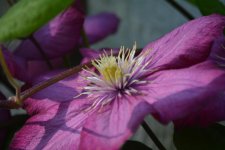You are using an out of date browser. It may not display this or other websites correctly.
You should upgrade or use an alternative browser.
You should upgrade or use an alternative browser.
all feedback welcome- clematis flower
- Thread starter LenspirationalPhotography
- Start date
LenspirationalPhotography
Senior Member
I could not say about that but generally you are better off photographing flowers on cloudy or cloudy bright days with the exception of having sunlight back lighting the blooms.
Thanks! I do take TONS of those pictures- I have SOO many pictures of flowers being backlit, it's crazy LOL! I will post some actually.
Little dark, little blurry. Need a faster shutter speed, improved hand-holding technique, tripod, or some combination of the group to sharpen your shot.
What I like? The perspective.
Thanks! Okay- I will use a combination of those 3 on these types of shots. Would this be classified as 90* sidelighting, anyone know?
Shooting across wide, flat flowers is also difficult, especially when lighting forces your settings -- where is your focus going to be? The petals at that angle are usually uninteresting and focusing on the stamen makes the blurring worse unless you can get a lot of DOF that close. Unless I have a specific purpose, I try to stay at least 30° above this type of flower's 'horizontal' plane.
LenspirationalPhotography
Senior Member
You should update you profile or add to your signature what camera you're shooting with. And... welcome.
yes, I will update my signature!
Shooting across wide, flat flowers is also difficult, especially when lighting forces your settings -- where is your focus going to be? The petals at that angle are usually uninteresting and focusing on the stamen makes the blurring worse unless you can get a lot of DOF that close. Unless I have a specific purpose, I try to stay at least 30° above this type of flower's 'horizontal' plane.
Okay, thank you! The focus was going to be the middle of the flower, and my goal was to do a 90* shot because that's one of my projects for my photography school, I will probably go back & reread that lesson.
my goal was to do a 90* shot because that's one of my projects for my photography school, I will probably go back & reread that lesson.
While Wev's suggestion is a good one, don't sweat it as you have a specific lesson you have to accomplish. Unless in your reread it's not a 90 degree shoot in the instructions LOL. Then you owe Wev for catching this LOL!
The focus was going to be the middle of the flower, and my goal was to do a 90* shot because that's one of my projects for my photography school, I will probably go back & reread that lesson.
For the sun to light your subject at a 90° angle, the sun should be lower in the sky--such as early morning or late in the evening. This would allow your subject to have one side of it lit.
LenspirationalPhotography
Senior Member
While Wev's suggestion is a good one, don't sweat it as you have a specific lesson you have to accomplish. Unless in your reread it's not a 90 degree shoot in the instructions LOL. Then you owe Wev for catching this LOL!
Thanks & yes the lesson says specifically to get a photo "using sidelighting to emphasize texture" it also says- "photograph an outdoor subject, with a surface that is emphasized by sunlight coming from about a 90* angle from the left or right". Can't use flash, & have to shoot in the early morning or evening (the picture taken in the thread was taken in the late evening as the sun was setting, in what photographers call "the golden hour".
For the sun to light your subject at a 90° angle, the sun should be lower in the sky--such as early morning or late in the evening. This would allow your subject to have one side of it lit.
okay, thank you!

